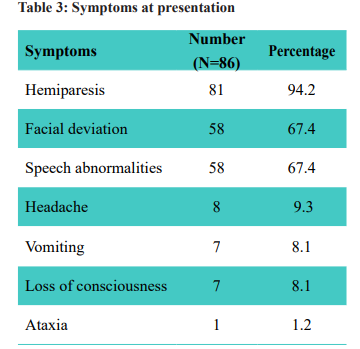Abstract
Background: Stroke is one of the most common cause of
morbidity and mortality worldwide. Approximately 50-85
percent of strokes are due to ischemic cerebral infarction
and 7-27 percent to intracerebral hemorrhage. Since the
incidence of stroke is increasing in our country, the study
aims to identify various factors associated with stroke.
Materials and Methods: This is a retrospective study
of 86 patients admitted in A & B International Hospital,
which is a private hospital located in Pokhara ,Nepal
from 1st January 2018 to 31st December 2019.The case
notes were taken from hospital record section and relevant
data extracted and analyzed. Approval from the hospital
management was taken prior to collecting the case notes.
Patients below 18 years of age, stroke due to trauma were
excluded. The data were collected, and were analyzed
using SPSS version 20.0 software
Results: Of the total 86 patients studied, the age range
was from 36 years to 94 years with mean age of 64.3
years. Mean age in ischemic stroke was 66.7 years and
in hemorrhagic stroke was 54.8 years. Stroke is more
common in men than female (2.3:1 ratio) .Ischemic stroke
accounted for 80.2 percent of cases and hemorrhagic stroke
for 19.2 percent. Most common presentation included limb
weakness, facial deviation and speech abnormality .Most
common vascular territory involved was MCA territory
infarction and small vessel strokes.
Conclusion: Stroke is prevalent in our country and the
incidence rises with age .Ischemic stroke is more prevalent
than hemorrhagic stroke. Mean age of hemorrhagic stroke
is lower than that of ischemic stroke and hypertension is
most commonly associated risk factor for both types of
stroke.
References
The World Health Organization MONICA
Project (monitoring trends and determinants in
cardiovascular disease): a major international collaboration. Journal of clinical epidemiology.
1988 Jan 1;41 (2):105-14.
2. Global, regional, and national burden of
neurological disorders, 1990-2016: a systematic
analysis for the Global Burden of Disease Study
2016. The Lancet Neurology. 2019;18(5):459-
80.
3. Feigin VL, Lawes CM, Bennett DA, BarkerCollo SL, Parag V. Worldwide stroke incidence
and early case fatality reported in 56 populationbased studies: a systematic review. The Lancet
Neurology. 2009;8(4):355-69.
4. Caplan LR. Basic pathology, anatomy, and
pathophysiology of stroke. In: Caplan’s Stroke:
A Clinical Approach, 4th ed, Saunders Elsevier,
Philadelphia 2009. p.22.
5. Feigin VL, Nguyen G, Cercy K, Johnson CO,
Alam T, Parmar PG, et al. Global, Regional,
and Country-Specific Lifetime Risks of Stroke,
1990 and 2016. The New England journal of
medicine. 2018;379(25):2429-37.
6. Madsen TE, Khoury JC, Leppert M, Alwell
K, Moomaw CJ, Sucharew H, et al. Temporal
Trends in Stroke Incidence Over Time
by Sex and Age in the GCNKSS. Stroke.
2020;51(4):1070-6.
7. Feigin VL, Forouzanfar MH, Krishnamurthi
R, Mensah GA, Connor M, Bennett DA, et al.
Global and regional burden of stroke during
1990-2010: findings from the Global Burden of
Disease Study 2010. Lancet (London, England).
2014;383(9913):245-54.
8. Vangen-Lønne AM, Wilsgaard T, Johnsen SH,
Løchen ML, Njølstad I, Mathiesen EB. Declining
Incidence of Ischemic Stroke: What Is the
Impact of Changing Risk Factors? The Tromsø
Study 1995 to 2012. Stroke. 2017;48(3):544-50
9. Dhungana K. Demographic characteristics of
stroke in a tertiary care hospital in Nepal. Nepal Journal of Neuroscience. 2018;15(3):54-8.
10. Habibi-Koolaee M, Shahmoradi L, Niakan
Kalhori SR, Ghannadan H, Younesi E.
Prevalence of Stroke Risk Factors and Their
Distribution Based on Stroke Subtypes in
Gorgan: A Retrospective Hospital-Based
Study-2015-2016. Neurology research
international. 2018;2018:2709654.
11. Sylaja PN, Pandian JD, Kaul S, Srivastava
MVP, Khurana D, Schwamm LH, et al. Ischemic
Stroke Profile, Risk Factors, and Outcomes
in India: The Indo-US Collaborative Stroke
Project. Stroke. 2018;49(1):219-22.
12. Maskey A, Parajuli M, Kohli SC. A study of risk
factors of stroke in patients admitted in Manipal
Teaching Hospital, Pokhara. Kathmandu
University medical journal. 2011;9(36):244-7.
13. Petty GW, Brown RD, Jr., Whisnant JP, Sicks JD,
O’Fallon WM, Wiebers DO. Ischemic stroke
subtypes: a population-based study of incidence
and risk factors. Stroke. 1999;30(12):2513-6
14. Shah RS, Cole JW. Smoking and stroke:
the more you smoke the more you stroke.
Expert review of cardiovascular therapy.
2010;8(7):917-32.
15. Kawachi I, Colditz GA, Stampfer MJ, Willett
WC, Manson JE, Rosner B, et al. Smoking
cessation and decreased risk of stroke in
women. Jama. 1993;269(2):232-6.
16. Vaidya C, Majmudar D. A retrospective study of
clinical profile of stroke patients from GMERS
Medical College and Hospital, Gandhinagar,
Gujarat. International Journal of Clinical Trials.
2014:62-6

